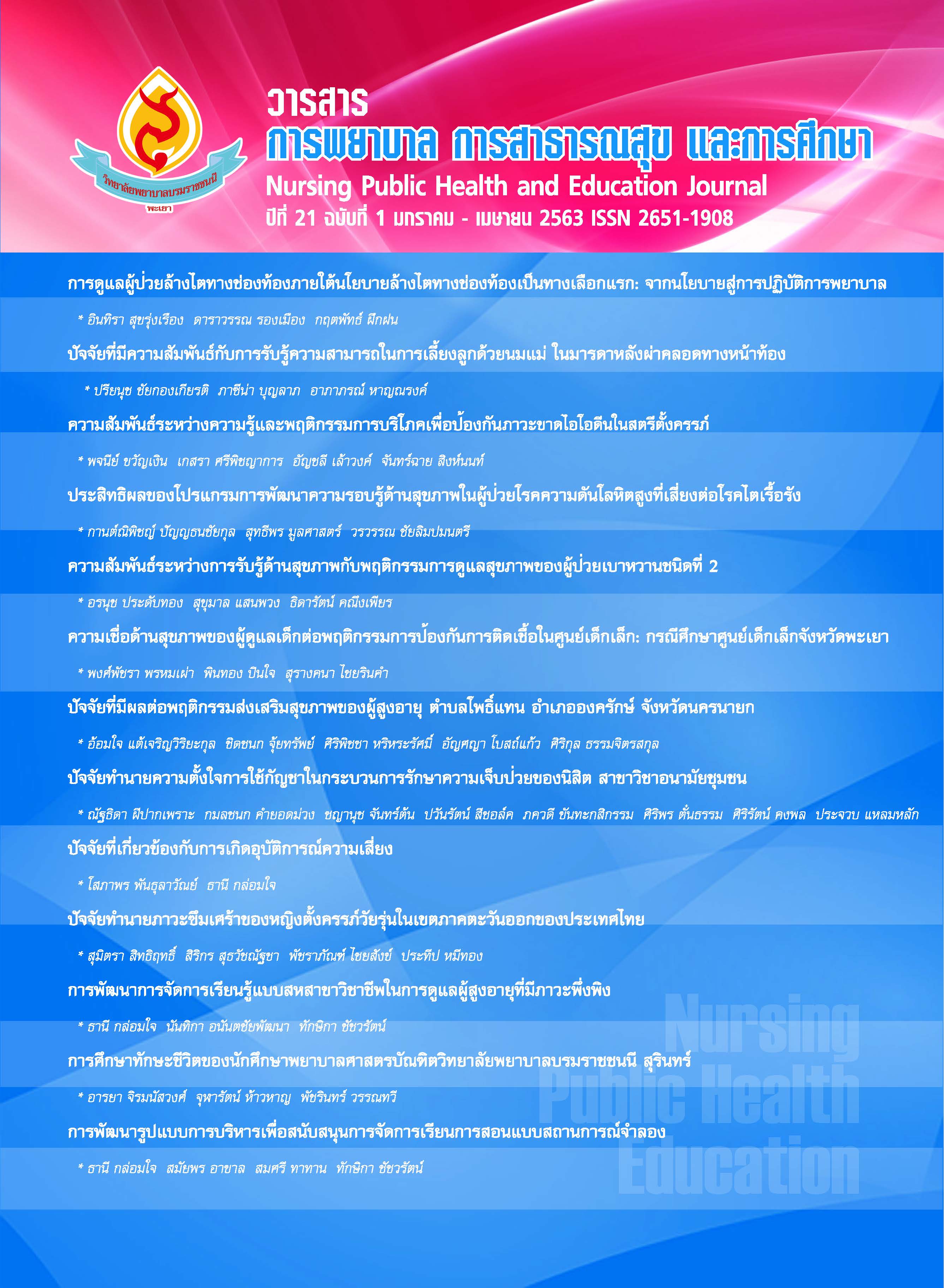การดูแลผู้ป่วยล้างไตทางช่องท้อง ภายใต้นโยบายล้างไตทางช่องท้องเป็นทางเลือกแรก: จากนโยบายสู่การปฏิบัติการพยาบาล
คำสำคัญ:
ล้างไตทางช่องท้อง, โรคไตเรื้อรังระยะสุดท้าย, นโยบายและการปฏิบัติบทคัดย่อ
โรคไตเรื้อรังเป็นปัญหาสุขภาพที่สำคัญของโลกรวมถึงประเทศไทย ผู้ป่วยกลุ่มนี้หากไม่ได้รับการดูแลรักษาที่เหมาะสมจะทำให้การดำเนินของโรคเลวลงจนเกิดภาวะไตเรื้อรังระยะสุดท้าย จำเป็นต้องรักษาด้วยวิธีการบำบัดทดแทนไต ทำให้เป็นภาระของผู้ป่วย ครอบครัว และประเทศชาติ พยาบาลเป็นบุคคลหนึ่งในทีมสุขภาพที่มีบทบาทสำคัญในการดูแลผู้ป่วยโรคไตเรื้อรังระยะสุดท้ายที่ได้รับการบำบัดทดแทนไตด้วยการล้างไตทางช่องท้องอย่างต่อเนื่อง การให้การดูแลที่ดีจะส่งผลให้การรักษามีประสิทธิภาพ ป้องกันการเกิดภาวะแทรกซ้อน ผู้ป่วยมีคุณภาพชีวิตที่ดี บทความวิชาการนี้มีจุดมุ่งหมายเพื่อนำเสนอ นโยบายที่เกี่ยวข้องกับการล้างไตทางช่องท้องอย่างต่อเนื่อง ปัจจัยแห่งความสำเร็จในการล้างไตทางช่องท้องอย่างต่อเนื่อง และบทบาทของพยาบาลในการดูแลผู้ป่วยที่ได้รับการรักษาโดยล้างไตทางช่องท้องอย่างต่อเนื่อง
เอกสารอ้างอิง
กระทรวงสาธารณสุข. (2562). ข้อมูลเพื่อตอบสนอง Service Plan สาขาไต.สืบค้นเมื่อ 29 ตุลาคม 2562, จากhttps://hdcservice.moph.go.th/hdc/reports/page.php?cat_id=e71a73a771474e63b71bccf727009ce.
กิติมา เศรษฐ์บุญสร้าง, และ ประเสริฐ ประสมรักษ์. (2559). การพัฒนารูปแบบการดูแลของผู้ป่วยโรคไตวายเรื้อรังระยะสุดท้ายที่ได้รับการบำบัดทดแทนไตต่อพฤติกรรมการดูแลตนเองและคุณภาพชีวิตผู้ป่วย โรงพยาบาลสมเด็จพระยุพราชเลิงนกทาจังหวัดยโสธร. วารสารการพัฒนาสุขภาพชุมชน มหาวิทยาลัยขอนแก่น, 4(4), 485-503.
เถลิงศักดิ์ กาญจนบุษย์. (2556). แนวปฏิบัติการล้างไตทางช่องท้อง. กรุงเทพฯ: บริษัท ศิริวัฒนาอินเตอร์พริ้นท์ จำกัด.
นงนุช ปัญจธรรมเจริญ, อัศนี วันชัย, และดอนคำ แก้วบุญเสริฐ. (2562). กระบวนการตัดสินใจเพื่อรับการรักษาด้วยวิธีการล้างไตทางหน้าท้องของผู้ป่วยโรคไตวายเรื้อรังระยะสุดท้ายโรงพยาบาลพะเยา. วารสารวิจัยทางวิทยาศาสตร์สุขภาพ,13(2), 1-10.
ประเสริฐ ธนกิจจารุ,สกานต์ บุนนาค, และวรางคณา พิชัยวงศ์. (2557). โรคไตเรื้อรัง. ใน ชุษณะ มะกรสาร (บ.ก), การแพทย์ไทย 2554-2557. นนทบุรี: กรมการแพทย์ กระทรวงสาธารณสุข.
สมาคมโรคไตแห่งประเทศไทย. (2015).Thailand renal replacement therapy year 2015. สืบค้นเมื่อ 29 ตุลาคม 2562, จาก http://www.neoscreen.go.th/web/images/stories/doc/nhso_2019.pdf.
สมาคมโรคไตแห่งประเทศไทย. (2558).คำแนะนำสำหรับการดูแลผู้ป่วยโรคไตเรื้อรังก่อนการบำบัดทดแทนไต พ.ศ. 2558. สืบค้นเมื่อ31ตุลาคม 2562, จากhttp://www.nephrothai.org/images/10-11-2016/Final_AD_CKD_2015.pdf.
สมาคมโรคไตแห่งประเทศไทย. (2559). Thailand PD KPI สมาคมโรคไตแห่งประเทศไทย.Thailand PD Newsletter,1(4). 3.
สำนักงานหลักประกันสุขภาพแห่งชาติ. (2561). คู่มือบริหารกองทุนหลักประกันสุขภาพแห่งชาติปีงบประมาณ 2562. นนทบุรี: บริษัท สหมิตรพริ้นติ้งแอนด์พับลิสชิ่ง จำกัด.
สำนักยุทธศาสตร์การแพทย์ กรมการแพทย์. (2560). แผนปฏิบัติการระยะ 5 ปี (พ.ศ. 2560 - 2561) ตามยุทธศาสตร์ชาติระยะ 20 ปี ด้านสาธารณสุข. สืบค้นเมื่อ 10 เมษายน 2563, จาก http://164.115.26.154/dmsplanv_2/plandms/plandms03122018031203.pdf
อรวรรณ ขันสำรี และสุชาดา รัชชุกูล. (2010). สมรรถนะพยาบาลวิชาชีพที่ให้การดูแลผู้ป่วยล้างไตทางช่องท้องโรงพยาบาลรัฐ. รามาธิบดีเวชสาร, 33(2), 57-64.
Bernardini,J., Price,V., &Figueiredo, A. (2006).Peritoneal dialysis patient training, 2006. Peritoneal Dialysis International, 26(6), 625–632.
Figueiredo, A. E., de Moraes, T. P., Bernardini, J., Eduardo, C., de-Figueiredo, P., Barretti, P.,…Pecoits-Filho, R. (2015). Impact of patient training patterns on peritonitis rates in a large national cohort study. Nephrology Dialysis Transplantation, 30(1), 137–142.
Gokal, R., &Mallick, N. P. (1999).Peritoneal dialysis.The Lancet, 353(9155), 823-828.
Gulcan, E., Kıdır, V., Keles, M., Cankaya, E., Uyanik, A., &Saatci, F. (2017). Factors affecting patient survival and technical survival in patients undergoing peritoneal dialysis. International Journal of Clinical and Experimental Medicine, 10(1), 1004-1014.
Hain, D.J. & Sandy, D. (2013). Partners in care: Patient empowerment through shared decision-making. Nephrology Nursing Journal 40(2), 153-157.
Hill, N. R., Fatoba, S. T., Oke , J. L., Hirst, J. A., O’Callaghan, C. A., Lasserson, D.S., et al. (2016). Global prevalence of chronic kidney disease: A systematic review and meta-analysis. PLoS ONE, 11(7): e0158765.
Jha, V.,&Modi, G. K. (2018). Getting to know the enemy better: The global burden of chronic kidney disease. Kidney International, 94(3), 462–464.
Kawaguchi, Y. (2007). Various obstacles to peritoneal dialysis development in Japan: too much money? Too much fear?.Peritoneal Dialysis International, 27(suppl 2), S56-S58.
Kwong, V. WK., & Li, P. KT. (2015). Peritoneal dialysis in Asia.Kidney Disease, 1(3), 147–156.
Martino, F., Adıbelli, Z., Mason, G., Nayak, A., Ariyanon, W., Rettore, E.,…Ronco, C. (2014). Home visit program improves technique survival in peritoneal dialysis. Blood Purifification, 37(4), 286–290.
National Kidney Foundation. (2007). A “new normal”: life on dialysis—the first 90 days. New York: National Kidney Foundation, Inc.
Van den Bosch, J., Warren, D. S., & Rutherford, P. A. (2015). Review of predialysis education programs: a need for standardization. Patient preference and adherence, 9, 1279–1291.
Wang, H., Naghavi, M., Allen, C., Barber, R. M., Bhutta, Z.A, Carter A, et al. (2016). Global, regional, and national life expectancy, all-cause mortality, and cause-specific mortality for 249 causes of death, 1980-2015: A systematic analysis for the Global Burden of Disease Study 2015. Lancet, 388(10053), 1459–1544.
Wagner, E.H., Austin, B.T., Davis, C., Hindmarsh, M., Schaefer, J., &Bonomi, A. (2001). Improving chronic illness care: translating evidence into action. Health Affairs (Millwood), 20(6), 64–78.
ดาวน์โหลด
เผยแพร่แล้ว
รูปแบบการอ้างอิง
ฉบับ
ประเภทบทความ
สัญญาอนุญาต
ลิขสิทธิ์ (c) 2020 วารสารการพยายาล การสาธารณสุข และการศึกษา

อนุญาตภายใต้เงื่อนไข Creative Commons Attribution-NonCommercial-NoDerivatives 4.0 International License.



